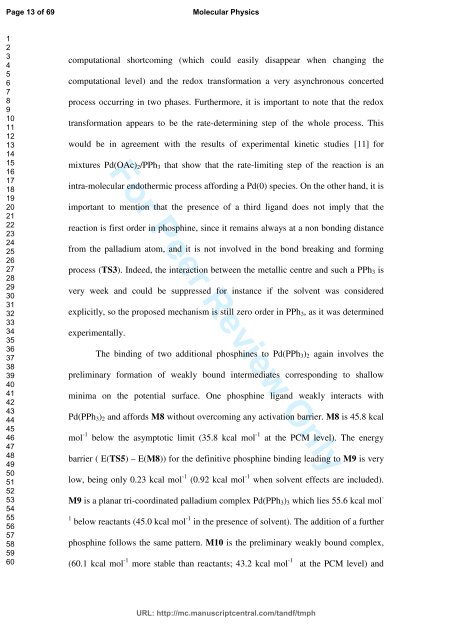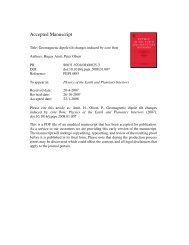For Peer Review Only - TARA
For Peer Review Only - TARA
For Peer Review Only - TARA
Create successful ePaper yourself
Turn your PDF publications into a flip-book with our unique Google optimized e-Paper software.
Page 13 of 69<br />
Molecular Physics<br />
1<br />
2<br />
3<br />
4<br />
5<br />
6<br />
7<br />
8<br />
9<br />
10<br />
11<br />
12<br />
13<br />
14<br />
15<br />
16<br />
17<br />
18<br />
19<br />
20<br />
21<br />
22<br />
23<br />
24<br />
25<br />
26<br />
27<br />
28<br />
29<br />
30<br />
31<br />
32<br />
33<br />
34<br />
35<br />
36<br />
37<br />
38<br />
39<br />
40<br />
41<br />
42<br />
43<br />
44<br />
45<br />
46<br />
47<br />
48<br />
49<br />
50<br />
51<br />
52<br />
53<br />
54<br />
55<br />
56<br />
57<br />
58<br />
59<br />
60<br />
computational shortcoming (which could easily disappear when changing the<br />
computational level) and the redox transformation a very asynchronous concerted<br />
process occurring in two phases. Furthermore, it is important to note that the redox<br />
transformation appears to be the rate-determining step of the whole process. This<br />
would be in agreement with the results of experimental kinetic studies [11] for<br />
<strong>For</strong> <strong>Peer</strong> <strong>Review</strong> <strong>Only</strong><br />
mixtures Pd(OAc) 2 /PPh 3 that show that the rate-limiting step of the reaction is an<br />
intra-molecular endothermic process affording a Pd(0) species. On the other hand, it is<br />
important to mention that the presence of a third ligand does not imply that the<br />
reaction is first order in phosphine, since it remains always at a non bonding distance<br />
from the palladium atom, and it is not involved in the bond breaking and forming<br />
process (TS3). Indeed, the interaction between the metallic centre and such a PPh 3 is<br />
very week and could be suppressed for instance if the solvent was considered<br />
explicitly, so the proposed mechanism is still zero order in PPh 3 , as it was determined<br />
experimentally.<br />
The binding of two additional phosphines to Pd(PPh 3 ) 2 again involves the<br />
preliminary formation of weakly bound intermediates corresponding to shallow<br />
minima on the potential surface. One phosphine ligand weakly interacts with<br />
Pd(PPh 3 ) 2 and affords M8 without overcoming any activation barrier. M8 is 45.8 kcal<br />
mol -1 below the asymptotic limit (35.8 kcal mol -1 at the PCM level). The energy<br />
barrier ( E(TS5) – E(M8)) for the definitive phosphine binding leading to M9 is very<br />
low, being only 0.23 kcal mol -1 (0.92 kcal mol -1 when solvent effects are included).<br />
M9 is a planar tri-coordinated palladium complex Pd(PPh 3 ) 3 which lies 55.6 kcal mol -<br />
1 below reactants (45.0 kcal mol -1 in the presence of solvent). The addition of a further<br />
phosphine follows the same pattern. M10 is the preliminary weakly bound complex,<br />
(60.1 kcal mol -1 more stable than reactants; 43.2 kcal mol -1 at the PCM level) and<br />
URL: http://mc.manuscriptcentral.com/tandf/tmph
















